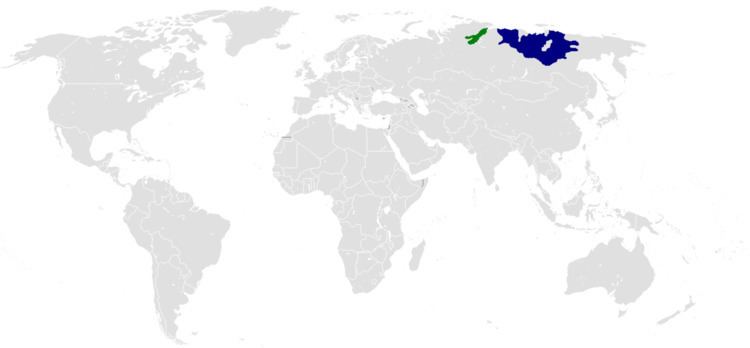Native to Russia Native speakers 450,000 (2010 census) | Region Sakha Writing system Cyrillic | |
 | ||
Ethnicity 480,000 Yakuts (2010 census) Language family Turkic
Common Turkic
Siberian
Northern
Yakut | ||
Yakut, also known as Sakha, is a Turkic language with around 450,000 native speakers spoken in the Sakha Republic in the Russian Federation by the Yakuts.
Contents
- Classification
- Geographic distribution
- Phonology
- Writing system
- Syntax
- Nouns
- Pronouns
- Questions
- Numbers
- Literature
- Oral traditions
- References
Like most Turkic languages and their ancestral Proto-Turkic, Yakut is an agglutinative language and employs vowel harmony.
Classification
Yakut is a member of the Northern Turkic family of languages, which includes Shor, Tuvan, and Dolgan in addition to Yakut. Like Turkish, Yakut has vowel harmony, is agglutinative and has no grammatical gender. Word order is usually subject–object–verb. Yakut has been influenced by Tungusic and Mongolian languages.
Geographic distribution
Yakut is spoken mainly in the Sakha Republic. It is also used by ethnic Yakut in Khabarovsk Region and a small diaspora in other parts of the Russian Federation, Turkey, and other parts of the world. Dolgan, a close relative of Yakut, considered by some a dialect, is spoken by Dolgans in Krasnoyarsk Region. Yakut is widely used as a lingua franca by other ethnic minorities in the Sakha Republic – more Dolgans, Evenks, Evens and Yukagirs speak Yakut than their own languages. About 8% of the people of other ethnicities than Yakut living in Sakha claimed knowledge of the Yakut language during the 2002 census.
Phonology
One characteristic feature of Yakut is vowel harmony. For example, if the first vowel of a Yakut word is a front vowel, the second and other vowels of the same word are usually the same vowel or another front vowel: кэлин (kelin) "back": э (e) is open unrounded front, и (i) is close unrounded front. Yakut initial s- corresponds to initial h- in Dolgan and played an important operative rule in the development of proto-Yakut, ultimately resulting in initial Ø- < *h- < *s-. Ubrjatova (1985) suggests that the rule was either reintroduced through Evenki contact, or may be a substratal feature of the Yakut language itself. An example is shown in the word meaning "not": Dolgan huoq and Yakut suox. This phonetic observation gave rise to two acknowledgements:
- that the original phenomenon in proto-Yakut may have likewise been the result of substratal influence.
- that the change of *s > h (debuccalization) is, however, well known and is far from unusual, being characteristic of such languages as Greek in its development from Proto-Indo-European, as well as such Turkic languages as Bashkir, e.g. höt 'milk' < *süt.
Writing system
Yakut is written using the Cyrillic script: the modern Yakut alphabet, established in 1939 by the Soviet Union, consists of the usual Russian characters but with 5 additional letters: Ҕҕ, Ҥҥ, Өө, Һһ, Үү.
Сахалыы сурук-бичигэ Saqalıı suruk-biçige (Yakut alphabet)
Syntax
The typical word order can be summarized as subject – adverb – object – verb; possessor – possessed; noun – adjective.
Nouns
Nouns have plural and singular forms. The plural is formed with the suffix /-LAr/, which may surface as -лар (-lar), -лэр (-ler), -лөр (-lör), -лор (-lor), -тар (-tar), -тэр (-ter), -төр (-tör), -тор (-tor), -дар (-dar), -дэр (-der), -дөр (-dör), -дор (-dor), -нар (-nar), -нэр (-ner), -нөр (-nör), or -нор (-nor), depending on the preceding consonants and vowels. The plural is used only when referring to a number of things collectively, not when specifying an amount. Nouns have no gender.
Pronouns
Personal pronouns in Yakut distinguish between first, second, and third persons and singular and plural number.
Although nouns have no gender, the pronoun system distinguishes between human and non-human in the third person, using кини (kini, 'he/she') to refer to human beings and ол (ol, 'it') to refer to all other things.
Questions
Question words in Yakut remain in-situ; they do not move to the front of the sentence. Sample question words include: туох (tuox) "what", ким (kim) "who", хайдах (xaydax) "how", хас (xas) "how much", ханна (xanna) "where", and ханнык (xannık) "which".
Numbers
In this table, the Yakut numbers are written in Latin transcription (see Writing system).
Literature
The first printing in Yakut was a part of a book by Nicolaas Witsen published in 1692 in Amsterdam.
In 2005, Marianne Beerle-Moor, director of the Institute for Bible Translation, Russia/CIS, was awarded the Order of Civil Valour by the Yakut Republic for the translation of the New Testament into Yakut.
Oral traditions
The Yakut have a tradition of oral epic in their language called "Olonkho", traditionally performed by skilled performers. Only a very few older performers of this Olonkho tradition are still alive. They have begun a program to teach young people to sing this in their language and revive it, though in a modified form.
